Question 1. Specific plaque hypothesis.
Answer:
- The specific plaque hypothesis states that not all plaque is pathogenic and its pathogenicity depends on the presence of certain specific microbial pathogens in plaque
- Specific microorganisms responsible for periodontal diseases release certain damaging factors called virulence factors which lead to host tissue destruction
Example: A.a. contains causes aggressive periodontitis
Question 2. Define dental plaque.
Answer:
- It is soft deposits that form biofilm adhering to the tooth surface or other hard surface in the cavity including removable and fixed restoration
Read And Learn More: Periodontics Question and Answers
Question 3. Composition of dental plaque.
Answer:
1. Micro-organisms:
- Bacteria
- Mycoplasm
- Fungi
- Protozoa
- Virus
2. Intracellular matrix:
- Organic:
- Carbohydrates
- Glycoproteins
- Lipids
- Inorganic:
- Calcium
- Phosphorous
- Magnesium
- Potassium
- Sodium
Question 4. Difference between Supragingival and Subgin. It is for the identification of causative agents given Plaque.
Answer:

Question 5. Difference between Tooth associated and Epi- thelium-associated plaque.
Answer:
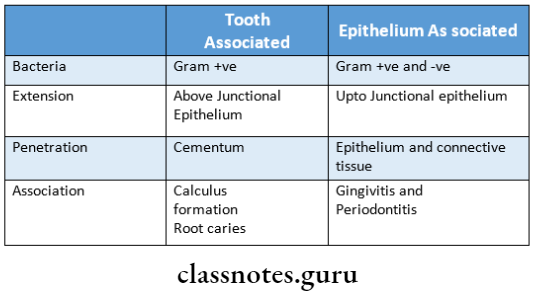
Question 6. Pellicle.
Answer:
Derived From:
- Components of saliva
- GCF
- Debris, bacterial, and host tissue cell products
Formed by: Selective adsorption of environment macromolecules
Functions:
- Acts as a protective barrier
- Lubricates surfaces to prevent tissue desiccation
- Provide substrate for bacterial attachment
Question 7. Socransky postulate.
Answer:
- It is for the identification of causative agents
- No. of etiologic organisms in the diseased site must be increased
- While it should be reduced in healthy sites
- If the etiologic organism is eliminated then disease pro-aggression ceases
- Presence of antibodies in organisms
- Presence of virulence factors
- In vitro, experiments should demonstrate the disease process
Question 8. Nonspecific Plaque Hypothesis.
Answer:
- It states that it is the total bulk of plaque that determines the pathogenicity rather than the individual species in it
- According to it. If a small amount of plaque is present then the products released by it can be neutralized by the host
- But if it is present in large quantity then it alters the host response
- It forms the basis of recent treatment and prevention modalities
Question 9. P. Gingivalis.
Answer:
- Porphyromonas gingivalis is a Gram-negative, anaerobic non-motile organism
- It is coccal to short rod shape
- It possesses fimbriae that facilitate adhesion and coag- aggregation
Virulence Factors:
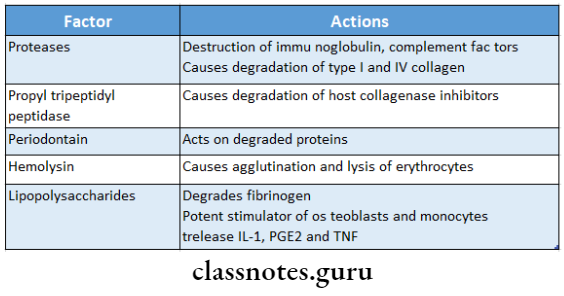
Question 10. A.a. contains.
Answer:
- Actinobaillus actinomycetemcomitans is also known as aggregatibacter actinomycetemcomitans
- It is gram-negative, capnophilic,non-motile saccharolytic
- It occurs singly, in clumps, or in pair
- It is a small, short straight, or curved rod in shape
Virulence Factors:
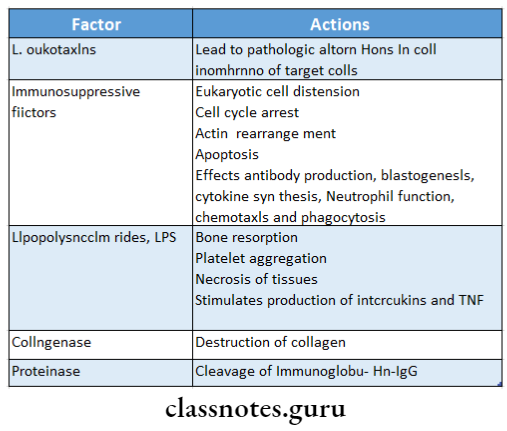
Question 11. Name the stages of plaque formation.
Answer:
Stages Of Plaque Formation:
- Formation of pellicle on the tooth surface
- Initial adhesion and attachment of bacteria
- Colonization and plaque maturation
Question 12. Normal oral bacterial flora.
Answer:
- Normal bacterial flora associated with clinically healthy periodontium comprises of
- Gram-positive cocci
- Fusiform bacilli
- Motile rods
- Filaments
- Spirochaetes
Question 13. Coaggregation.
Answer:
- In the process of plaque formation, the bacterial adherence to one another is termed coaggregation
- In the early stages of plaque formation there is coaggre It leads to food impaction nation between gram-negative and gram-positive organisms such as F. nucleatum and A. viscous followed by coaggregation in later stages between gram-negative organisms, F.nucleatum, and P. gingivalis
Question 14. Spirochaetes.
Answer:
- Spirochaetes are corkscrew-like gram-negative anaerobic bacteria
- They are capable of immunosuppression
- They contain endotoxin that contributes to their path- Tends to accumulate on a gingival third of teeth genericity
- Treponema vincentii is responsible for necrotizing ulcerative gingivitis
- Increased levels of spirochetes occur in chronic and aggressive periodontitis
- Treponema pallidum is important in the pathogenesis of periodontal diseases
- A decrease in the levels of spirochaetes results in im- improvement in periodontal health
Question 15. Prevotella intermedia.
Answer:
- It is a Gram-negative, anaerobic organism
- It has short rods with rounded ends
- Possess fimbriae
Virulence Factors:
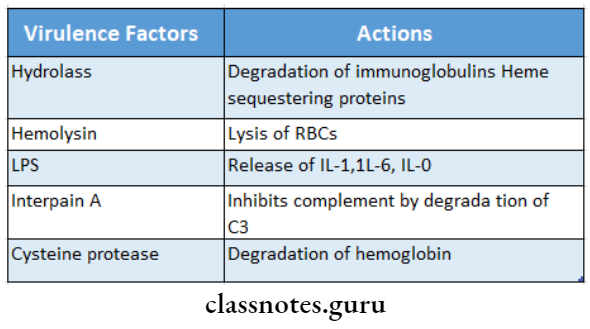
Question 16. Plunger Cusps.
Answer:
- Cusps that tend to forcibly wedge food interproximal are called plunger cusps
- It leads to food impaction
- Further results in gingivitis, periodontitis, tooth mobility, and pocket formation
Question 17. Materia alba.
Answer:
- Yellow/grayish-white, soft, sticky deposit, less adherent
Composition:
- Micro-organisms, desquamated epithelial cells, leukocytes, a mixture of salivary proteins and lipids
They are capable of immunosuppression cytes, a mixture of salivary proteins and lipids - Clearly visible, flushed away easily with water
- Tends to accumulate on the gingival third of teeth
Question 18. Bacterial Adherence/Formation.
Answer:
1. Via Electrostatic Interactions:
Negatively charged bacteria 11 calcium
↓↑
Negatively charged pellicle
2. Via Hydrophobic Interactions:
- Based on the fit of molecules of pellicle and plaque
- Lipoteichoic acid is responsible for this interaction by providing a long hydrophobic area
3. Via Lectin-like Substances:
- Lectin recognizes specific carbohydrates in the pellicle and becomes linked to it.

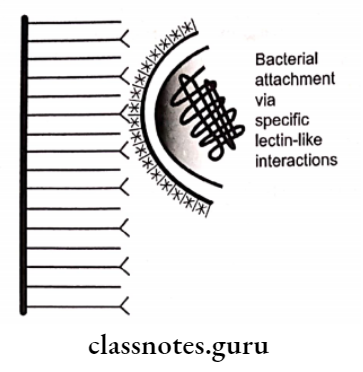
Question 19. Plaque Hypothesis.
Answer:
Non-Specific Plaque Hypothesis:
- States that the total bulk of plaque determines pathogenic- city rather than the species
- When only a small amount of plaque is present, it gets neutralized
- When a large amount of plaque is present, it causes disease
Specific Plaque Hypothesis:
- States that not all plaque is pathogenic and its path- genericity depends on the presence of certain specific pathogens in plaque
- Specific micro-organisms responsible for periodontal diseases release certain damaging factors
- This mediates the destruction of host tissue
Proof: Presence of A.a. contains in localized juvenile periodontitis
Question 20. Red complex
Answer:
- Secondary colonizers form red complex
- It consists of
- P. gingivalis
- T. denticola
- B. forsythias
- It is responsible for bleeding on probing
